Evapotranspiration Measurements and Assessment of Driving Factors: A Comparison of Different Green Roof Systems during Summer in Germany
Abstract
:1. Introduction
2. Materials and Methods
2.1. Site Description
2.2. Experimental Setup
2.3. Green Roof Systems Description
2.4. Roof Maintenance
2.5. Data Processing
2.6. Calculation of Vegetation Cover and Plant Area Index
2.7. Determination of Evapotranspiration
2.8. Statistical Analysis
3. Results
3.1. Weather Conditions
3.2. Vegetation Development
3.3. Substrate Moisture
3.4. Evapotranspiration
3.5. Variable Importance in Projection (VIP) Scores
3.6. Substrate Temperature and Air Temperature at Vegetation Level
4. Discussion
4.1. Soil Moisture
4.2. Evapotranspiration
4.3. Variable Importance in Projection (VIP) Scores
4.4. Substrate Temperature and Air Temperature at Vegetation Level
4.5. Limitations and Outlook
5. Conclusions
Author Contributions
Funding
Institutional Review Board Statement
Informed Consent Statement
Data Availability Statement
Acknowledgments
Conflicts of Interest
Appendix A


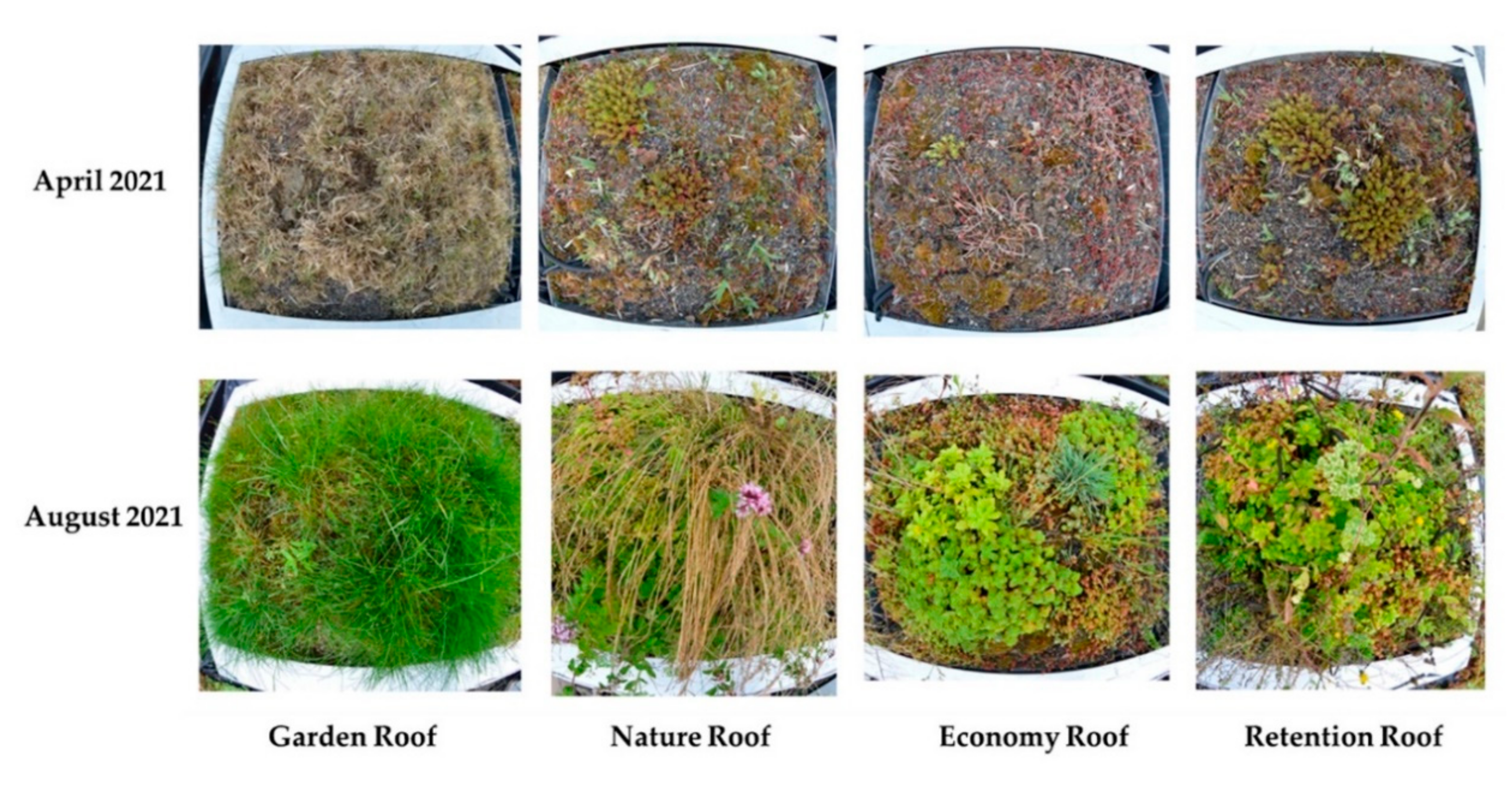
References
- Masson-Delmotte, V.; Zhai, P.; Pirani, A.; Connors, S.L.; Péan, C.; Berger, S.; Caud, N.; Chen, Y.; Goldfarb, L.; Gomis, M.I.; et al. Summary for Policymakers. In Climate Change 2021: The Physical Science Basis. Contribution of Working Group I to the Sixth Assessment Report of the Intergovernmental Panel on Climate Change; Cambridge University: Cambridge, UK, 2021. [Google Scholar]
- Oke, T.R. The Energetic Basis of the Urban Heat Island. Q. J. R. Meteorol. Soc. 1982, 108, 1–24. [Google Scholar] [CrossRef]
- Ward, K.; Lauf, S.; Kleinschmit, B.; Endlicher, W. Heat Waves and Urban Heat Islands in Europe: A Review of Relevant Drivers. Sci. Total Environ. 2016, 569–570, 527–539. [Google Scholar] [CrossRef]
- Liu, W.; Engel, B.A.; Feng, Q. Modelling the Hydrological Responses of Green Roofs under Different Substrate Designs and Rainfall Characteristics Using a Simple Water Balance Model. J. Hydrol. 2021, 602, 126786. [Google Scholar] [CrossRef]
- Hart, M.A.; Sailor, D.J. Quantifying the Influence of Land-Use and Surface Characteristics on Spatial Variability in the Urban Heat Island. Theor. Appl. Climatol. 2009, 95, 397–406. [Google Scholar] [CrossRef]
- George, L.A.; Becker, W.G. Investigating the Urban Heat Island Effect with a Collaborative Inquiry Project. J. Geosci. Educ. 2003, 51, 237–243. [Google Scholar] [CrossRef] [Green Version]
- Santamouris, M. Heat Island Research in Europe: The State of the Art. Adv. Build. Energy Res. 2007, 1, 123–150. [Google Scholar] [CrossRef]
- Deutscher Wetterdienst. Available online: https://www.dwd.de/DE/klimaumwelt/klimaforschung/klimawirk/stadtpl/projekt_waermeinseln/sksm/sksm_node.html (accessed on 7 September 2021).
- Kendrovski, V.; Baccini, M.; Martinez, G.; Wolf, T.; Paunovic, E.; Menne, B. Quantifying Projected Heat Mortality Impacts under 21st-Century Warming Conditions for Selected European Countries. Int. J. Environ. Res. Public. Health 2017, 14, 729. [Google Scholar] [CrossRef] [PubMed] [Green Version]
- Krug, A.; Mücke, H.-G. Auswertung Hitze-Bezogener Indikatoren Als Orientierung Der Gesundheitlichen Belastung. UMID Umw. Und Mensch-Inf. 2018, 2, 70–74. [Google Scholar]
- Christenson, E.; Elliott, M.; Banerjee, O.; Hamrick, L.; Bartram, J. Climate-Related Hazards: A Method for Global Assessment of Urban and Rural Population Exposure to Cyclones, Droughts, and Floods. Int. J. Environ. Res. Public Health 2014, 11, 2169–2192. [Google Scholar] [CrossRef] [PubMed]
- Gabriel, K.M.A.; Endlicher, W.R. Urban and Rural Mortality Rates during Heat Waves in Berlin and Brandenburg, Germany. Environ. Pollut. 2011, 159, 2044–2050. [Google Scholar] [CrossRef]
- United Nations: Department of Economic and Social Affairs, Population Division. World Urbanization Prospects: The 2018 Revision; United Nations: New York, NY, USA, 2019; ISBN 978-92-1-148319-2. [Google Scholar]
- Manso, M.; Teotónio, I.; Silva, C.M.; Cruz, C.O. Green Roof and Green Wall Benefits and Costs: A Review of the Quantitative Evidence. Renew. Sustain. Energy Rev. 2021, 135, 110111. [Google Scholar] [CrossRef]
- Krayenhoff, E.S.; Broadbent, A.M.; Zhao, L.; Georgescu, M.; Middel, A.; Voogt, J.A.; Martilli, A.; Sailor, D.J.; Erell, E. Cooling Hot Cities: A Systematic and Critical Review of the Numerical Modelling Literature. Environ. Res. Lett. 2021, 16, 053007. [Google Scholar] [CrossRef]
- Mentens, J.; Raes, D.; Hermy, M. Green Roofs as a Tool for Solving the Rainwater Runoff Problem in the Urbanized 21st Century? Landsc. Urban Plan. 2006, 77, 217–226. [Google Scholar] [CrossRef]
- Filazzola, A.; Shrestha, N.; MacIvor, J.S. The Contribution of Constructed Green Infrastructure to Urban Biodiversity: A Synthesis and Meta-analysis. J. Appl. Ecol. 2019, 56, 2131–2143. [Google Scholar] [CrossRef]
- Ran, J.; Yang, Z.; Feng, Y.; Xiong, K.; Tang, M. Energy Performance Assessment and Optimization of Extensive Green Roofs in Different Climate Zones of China. E3S Web Conf. 2020, 172, 16003. [Google Scholar] [CrossRef]
- Lee, K.E.; Williams, K.J.H.; Sargent, L.D.; Farrell, C.; Williams, N.S. Living Roof Preference Is Influenced by Plant Characteristics and Diversity. Landsc. Urban Plan. 2014, 122, 152–159. [Google Scholar] [CrossRef]
- Lee, K.E.; Sargent, L.D.; Williams, N.S.G.; Williams, K.J.H. Linking Green Micro-Breaks with Mood and Performance: Mediating Roles of Coherence and Effort. J. Environ. Psychol. 2018, 60, 81–88. [Google Scholar] [CrossRef]
- Versini, P.-A.; Gires, A.; Tchiguirinskaia, I.; Schertzer, D. Fractal Analysis of Green Roof Spatial Implementation in European Cities. Urban For. Urban Green. 2020, 49, 126629. [Google Scholar] [CrossRef]
- Lomba-Fernández, C.; Hernantes, J.; Labaka, L. Labaka Guide for Climate-Resilient Cities: An Urban Critical Infrastructures Approach. Sustainability 2019, 11, 4727. [Google Scholar] [CrossRef] [Green Version]
- Yang, J.; Wang, Z.-H. Physical Parameterization and Sensitivity of Urban Hydrological Models: Application to Green Roof Systems. Build. Environ. 2014, 75, 250–263. [Google Scholar] [CrossRef]
- Balany, F.; Ng, A.W.; Muttil, N.; Muthukumaran, S.; Wong, M.S. Green Infrastructure as an Urban Heat Island Mitigation Strategy—A Review. Water 2020, 12, 3577. [Google Scholar] [CrossRef]
- Vijayaraghavan, K. Green Roofs: A Critical Review on the Role of Components, Benefits, Limitations and Trends. Renew. Sustain. Energy Rev. 2016, 57, 740–752. [Google Scholar] [CrossRef]
- Peng, L.; Jim, C. Green-Roof Effects on Neighborhood Microclimate and Human Thermal Sensation. Energies 2013, 6, 598–618. [Google Scholar] [CrossRef] [Green Version]
- Morakinyo, T.E.; Dahanayake, K.W.D.; Kalani, C.; Ng, E.; Chow, C.L. Temperature and Cooling Demand Reduction by Green-Roof Types in Different Climates and Urban Densities: A Co-Simulation Parametric Study. Energy Build. 2017, 145, 226–237. [Google Scholar] [CrossRef]
- Cascone, S.; Coma, J.; Gagliano, A.; Pérez, G. The Evapotranspiration Process in Green Roofs: A Review. Build. Environ. 2019, 147, 337–355. [Google Scholar] [CrossRef]
- Kaiser, D.; Köhler, M.; Schmidt, M.; Wolff, F. Increasing Evapotranspiration on Extensive Green Roofs by Changing Substrate Depths, Construction, and Additional Irrigation. Buildings 2019, 9, 173. [Google Scholar] [CrossRef] [Green Version]
- Feng, Y.; Burian, S.; Pardyjak, E. Observation and Estimation of Evapotranspiration from an Irrigated Green Roof in a Rain-Scarce Environment. Water 2018, 10, 262. [Google Scholar] [CrossRef] [Green Version]
- Wang, C.; Wang, Z.-H.; Kaloush, K.E.; Shacat, J. Perceptions of Urban Heat Island Mitigation and Implementation Strategies: Survey and Gap Analysis. Sustain. Cities Soc. 2021, 66, 102687. [Google Scholar] [CrossRef]
- Beck, H.E.; Zimmermann, N.E.; McVicar, T.R.; Vergopolan, N.; Berg, A.; Wood, E.F. Present and Future Köppen-Geiger Climate Classification Maps at 1-Km Resolution. Sci. Data 2018, 5, 180214. [Google Scholar] [CrossRef] [Green Version]
- Wetterdienst.De. Available online: https://www.wetterdienst.de/Deutschlandwetter/Krauchenwies/Klima/ (accessed on 15 October 2021).
- Dachbegrünungsrichtlinien—Richtlinien Für Die Planung, Bau Und Instandhaltung von Dachbegrünungen; Landschaftsbau, F.L. (Ed.) Landschaftsentwicklung Landschaftsbau e.V: Bonn, Germany, 2018. [Google Scholar]
- RStudio Team. RStudio Desktop; RStudio: Boston, MA, USA, 2020. [Google Scholar]
- R Core Team. R: A Language and Environment for Statistical Computing; R Foundation for Statistical Computing: Vienna, Austria, 2020. [Google Scholar]
- Kessler, W. Multivariate Datenanalyse: Für die Pharma-, Bio- und Prozessanalytik ein Lehrbuch; Wiley-VCH: Weinheim, Germany, 2008; ISBN 978-3-527-31262-7. [Google Scholar]
- Wai, C.M.; Weise, S.E.; Ozersky, P.; Mockler, T.C.; Michael, T.P.; VanBuren, R. Time of Day and Network Reprogramming during Drought Induced CAM Photosynthesis in Sedum Album. PLoS Genet. 2019, 15, e1008209. [Google Scholar] [CrossRef] [PubMed] [Green Version]
- Lee, H.S.J.; Griffiths, H. Induction and Repression of CAM in Sedum Telephium L. in Response to Photoperiod and Water Stress. J. Exp. Bot. 1987, 38, 834–841. [Google Scholar] [CrossRef]
- Wold, S. PLS for Multivariate Linear Modeling. In Chemometric Methods in Molecular Design; Van de Waterbeemd, H., Ed.; Wiley-VCH Verlag GmbH & Co. KGaA: Weinheim, Germany, 1994; ISBN 3-527-3004-9. [Google Scholar]
- Cai, J.; Liu, Y.; Lei, T.; Pereira, L.S. Estimating Reference Evapotranspiration with the FAO Penman–Monteith Equation Using Daily Weather Forecast Messages. Agric. For. Meteorol. 2007, 145, 22–35. [Google Scholar] [CrossRef]
- Allen, R.G.; Pereira, L.S.; Raes, D.; Smith, M. Crop Evapotranspiration-Guidelines for Computing Crop Water Requirements; FAO Irrigation and Drainage Paper; repr.; Food and Agriculture Organization of the United Nations: Rome, Italy, 2000; ISBN 978-92-5-104219-9. [Google Scholar]
- Mehmood, T.; Sæbø, S.; Liland, K.H. Comparison of Variable Selection Methods in Partial Least Squares Regression. J. Chemom. 2020, 34, e3226. [Google Scholar] [CrossRef] [Green Version]
- Liu, L.; Zhang, R.; Zuo, Z. The Relationship between Soil Moisture and LAI in Different Types of Soil in Central Eastern China. J. Hydrometeorol. 2016, 17, 2733–2742. [Google Scholar] [CrossRef]
- Jahanfar, A.; Drake, J.; Gharabaghi, B.; Sleep, B. An Experimental and Modeling Study of Evapotranspiration from Integrated Green Roof Photovoltaic Systems. Ecol. Eng. 2020, 152, 105767. [Google Scholar] [CrossRef]
- Reyes, R.; Bustamante, W.; Gironás, J.; Pastén, P.A.; Rojas, V.; Suárez, F.; Vera, S.; Victorero, F.; Bonilla, C.A. Effect of Substrate Depth and Roof Layers on Green Roof Temperature and Water Requirements in a Semi-Arid Climate. Ecol. Eng. 2016, 97, 624–632. [Google Scholar] [CrossRef]
- Eksi, M.; Rowe, D.B.; Wichman, I.S.; Andresen, J.A. Effect of Substrate Depth, Vegetation Type, and Season on Green Roof Thermal Properties. Energy Build. 2017, 145, 174–187. [Google Scholar] [CrossRef] [Green Version]
- Pianella, A.; Aye, L.; Chen, Z.; Williams, N. Substrate Depth, Vegetation and Irrigation Affect Green Roof Thermal Performance in a Mediterranean Type Climate. Sustainability 2017, 9, 1451. [Google Scholar] [CrossRef] [Green Version]
- Jim, C.Y.; Peng, L.L.H. Substrate Moisture Effect on Water Balance and Thermal Regime of a Tropical Extensive Green Roof. Ecol. Eng. 2012, 47, 9–23. [Google Scholar] [CrossRef]
- Heusinger, J.; Sailor, D.J.; Weber, S. Modeling the Reduction of Urban Excess Heat by Green Roofs with Respect to Different Irrigation Scenarios. Build. Environ. 2018, 131, 174–183. [Google Scholar] [CrossRef]
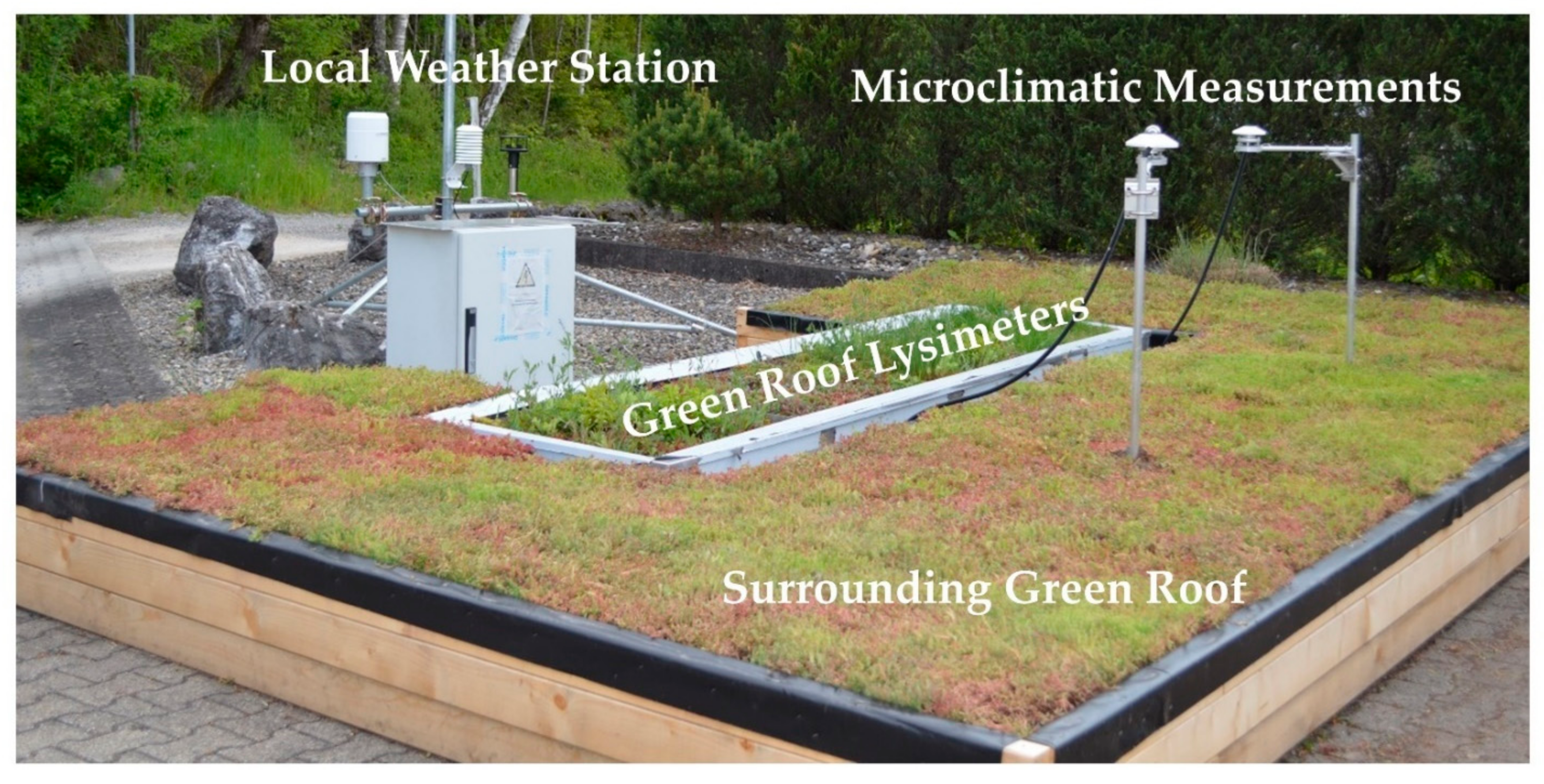
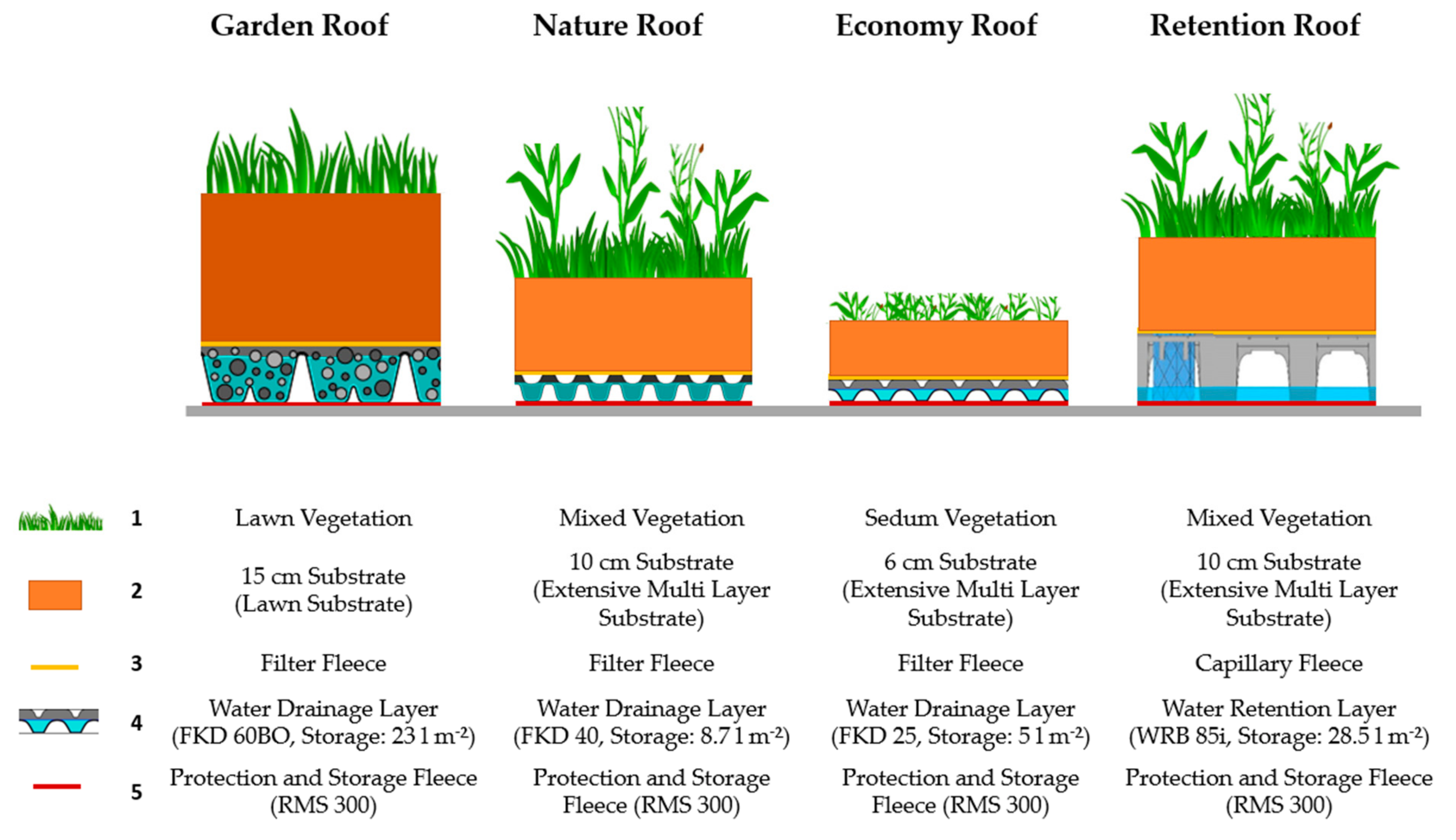
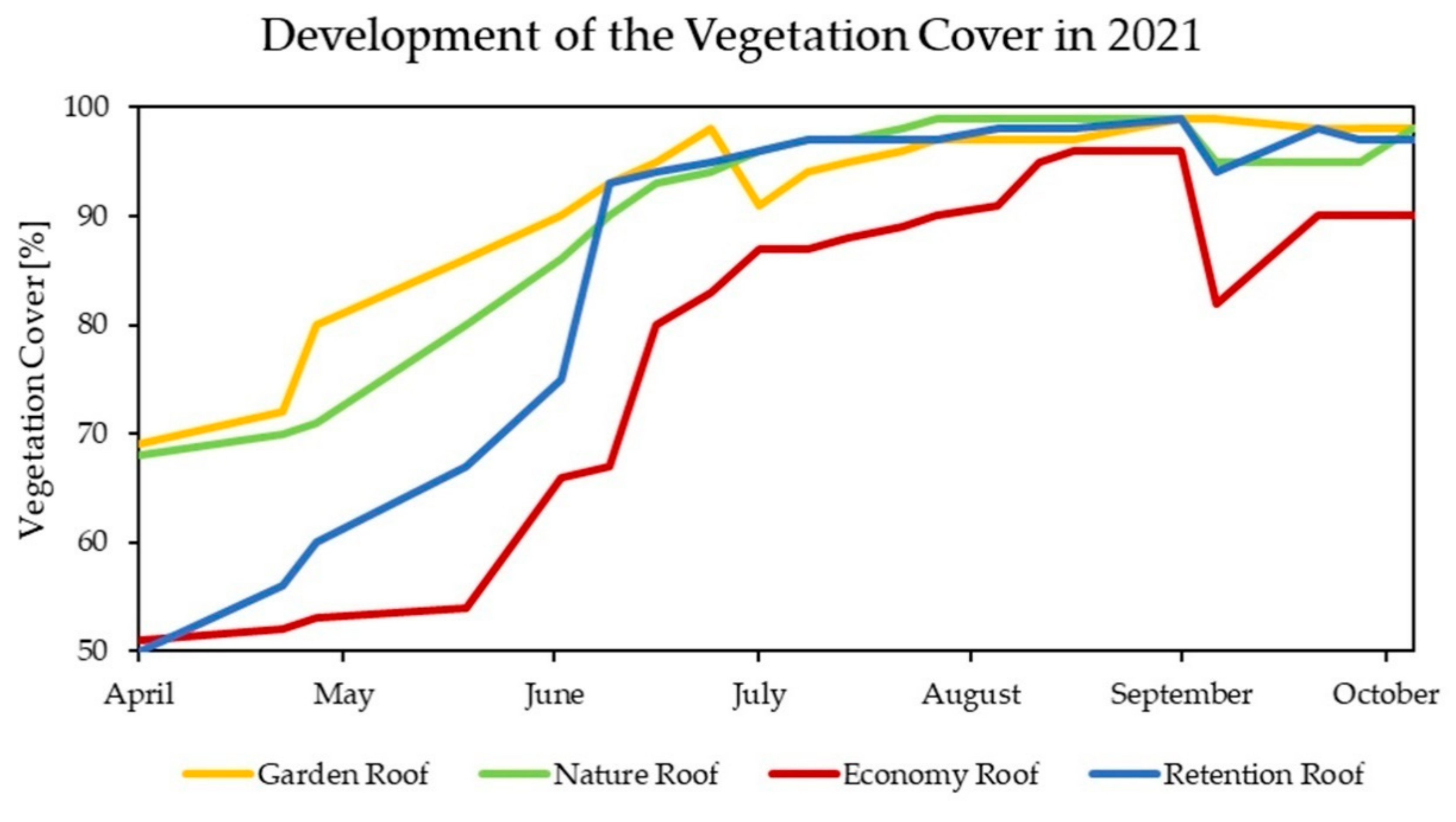
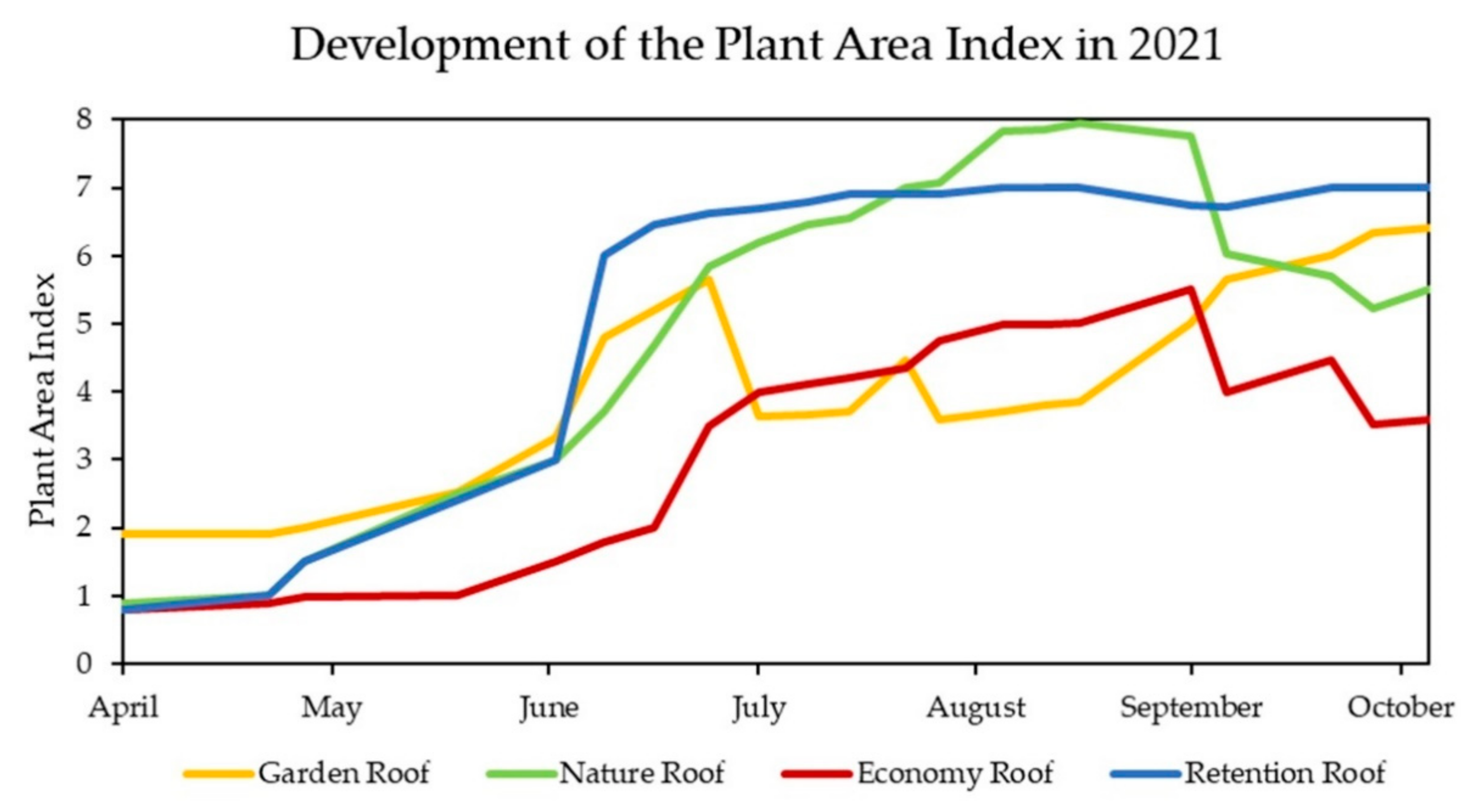

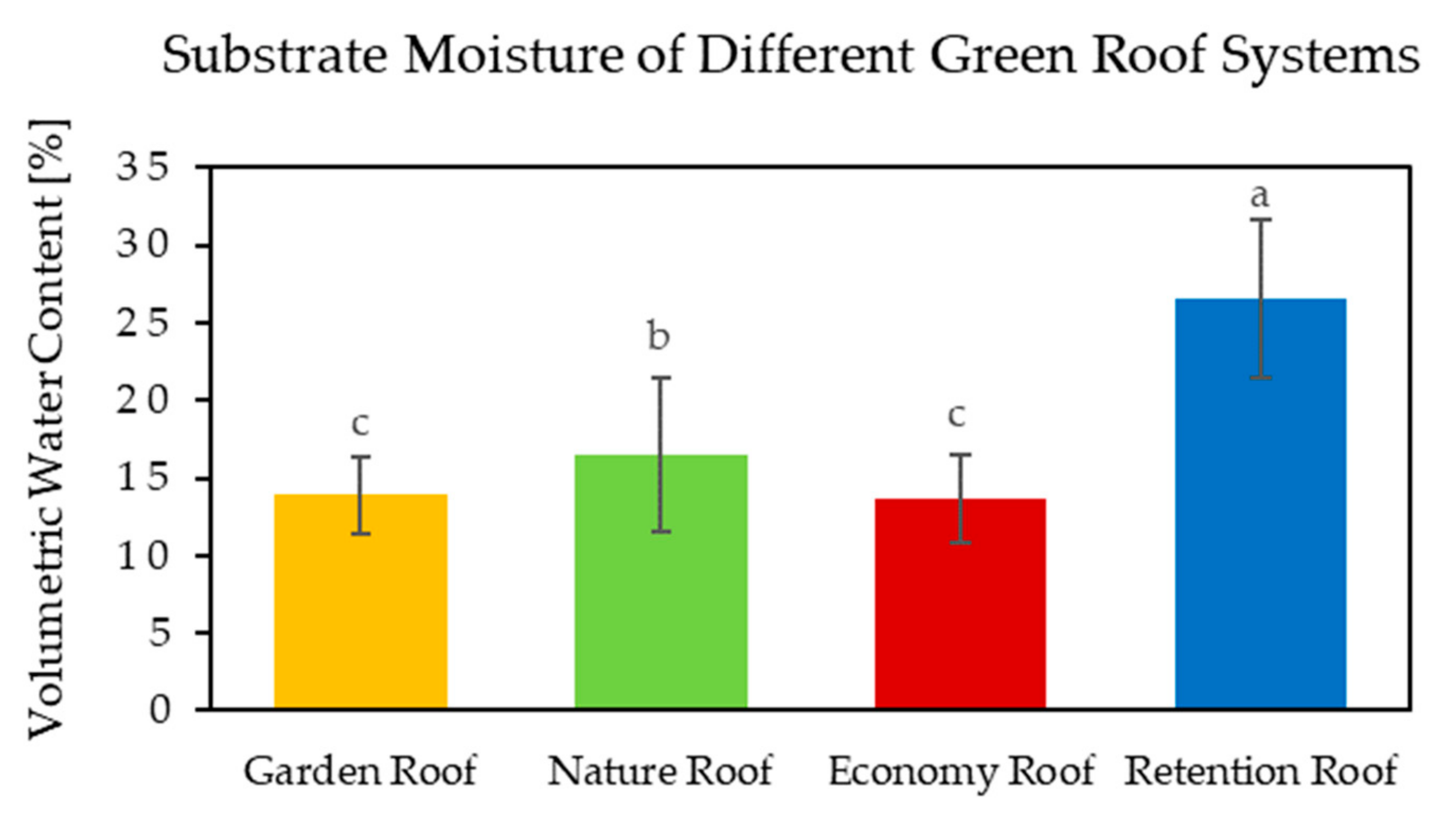
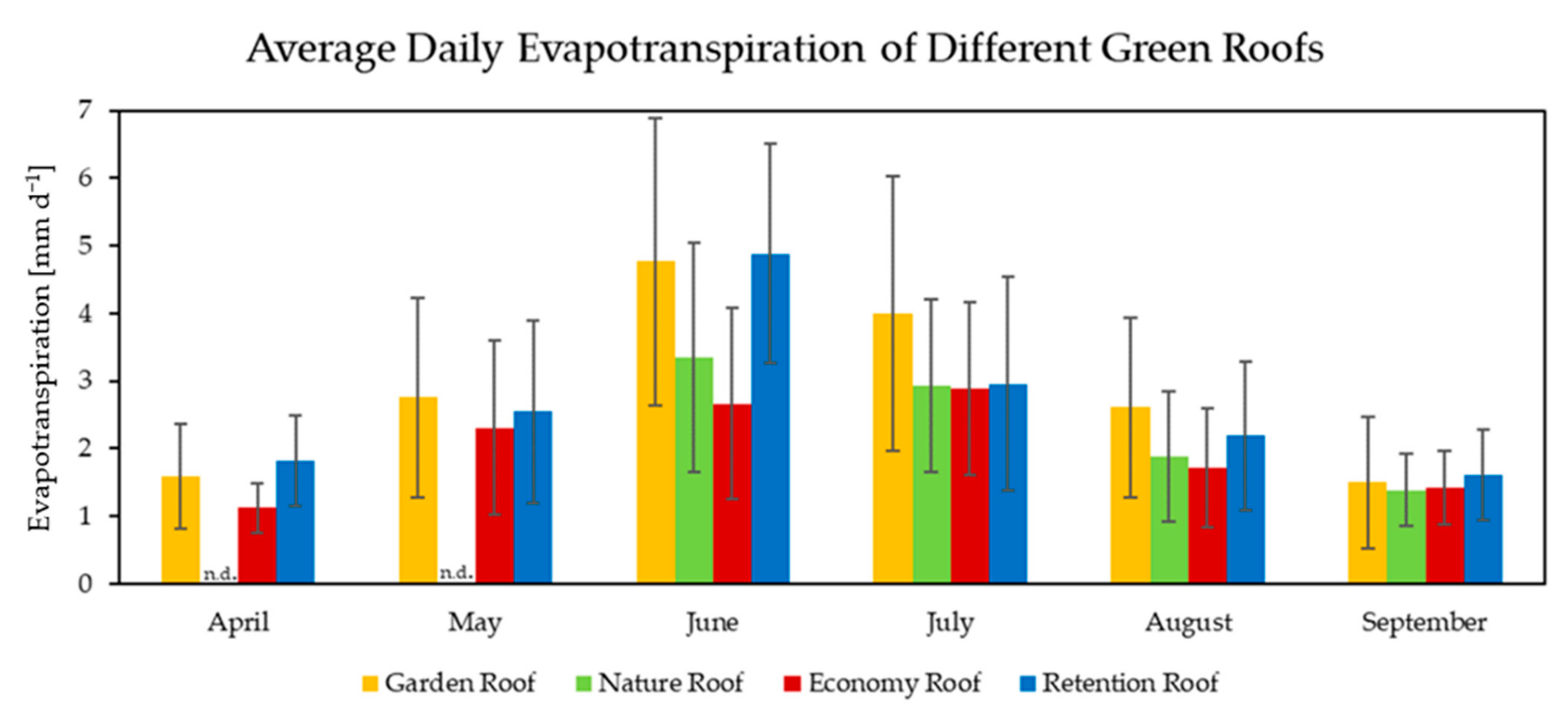
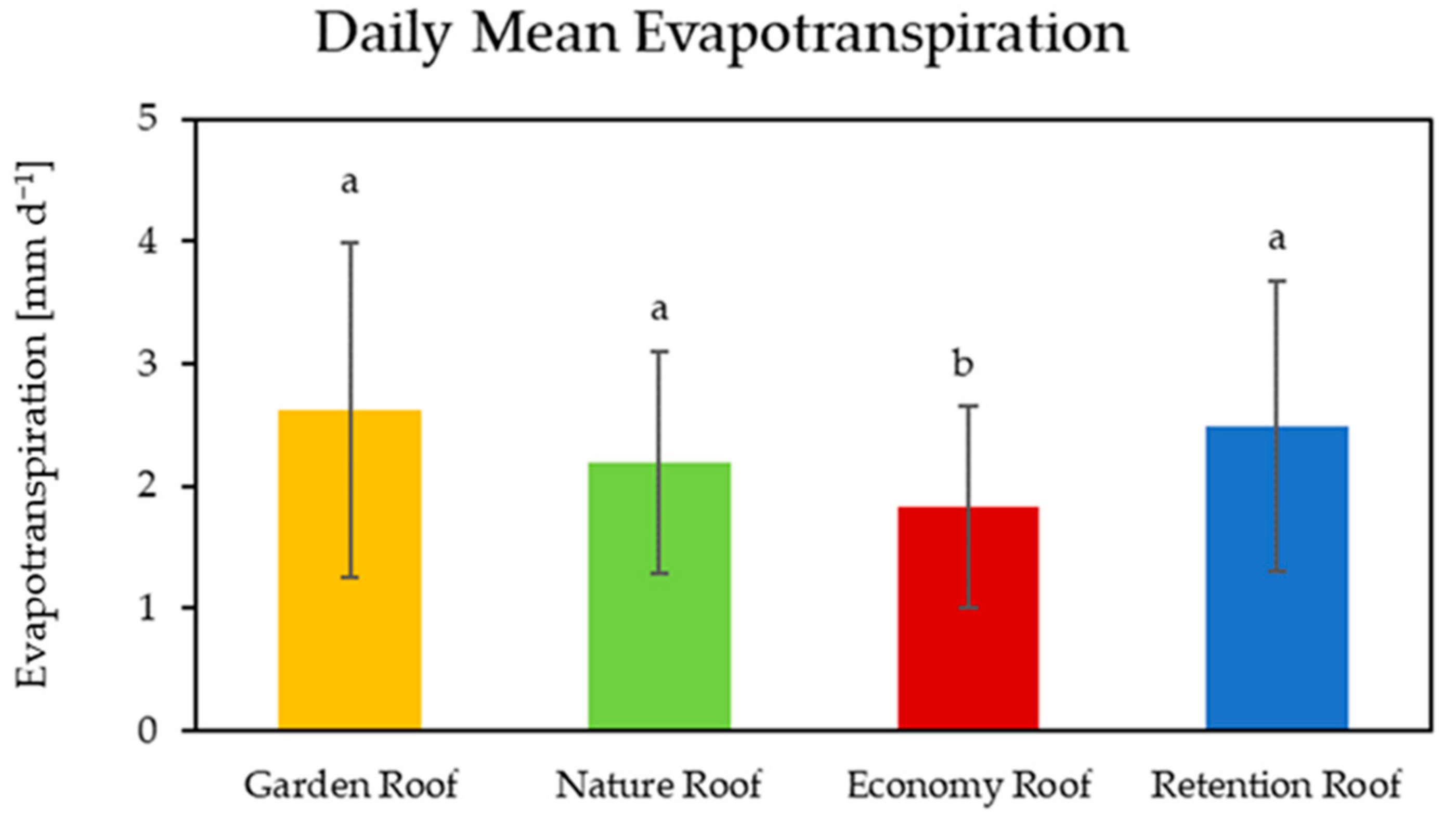
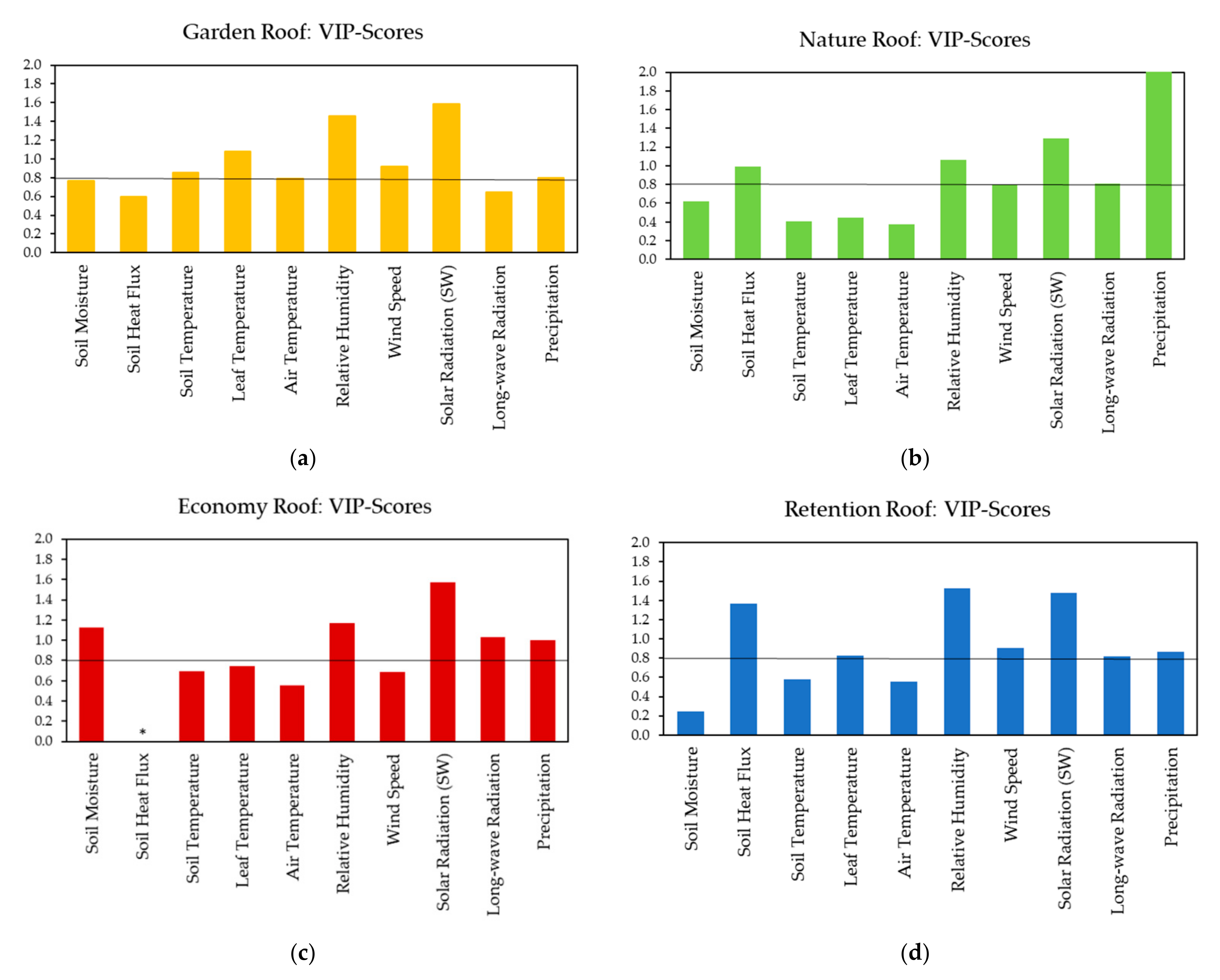

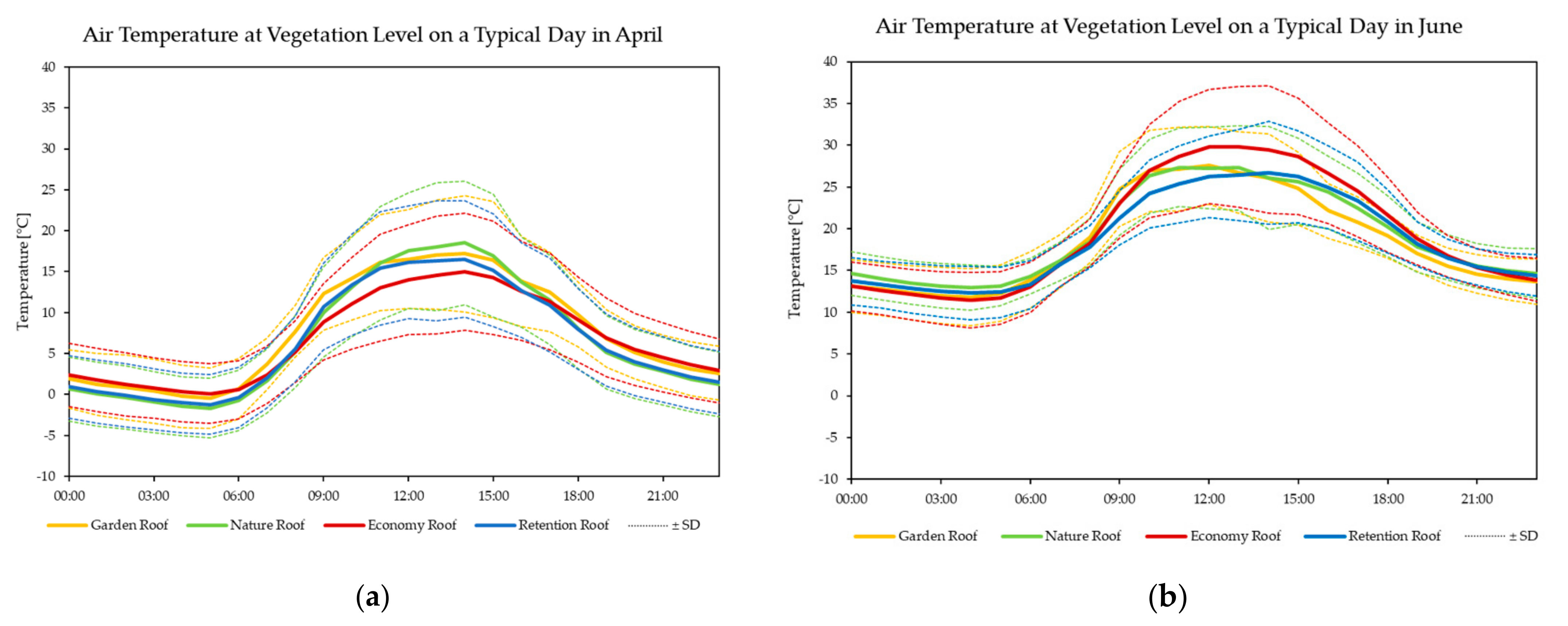
| Layer | Parameter | Measurement Device | Manufacturer |
|---|---|---|---|
| Atmospheric Layer | Precipitation | rain[e] | LAMBRECHT meteo GmbH, Göttingen, Germany |
| Air Temperature | CS215 Temperature and Relative Humidity Probe | Campbell Scientific Inc., Logan, UT, USA | |
| Relative Humidity | CS215 Temperature and Relative Humidity Probe | Campbell Scientific Inc., Logan, UT, USA | |
| Short-Wave Solar Radiation | CMP10 Pyranometer | Kipp & Zonen B.V., Delft, The Netherlands | |
| Long-Wave Radiation | CGR3 Pyrgeometer (facing the sky) | Kipp & Zonen B.V., The Netherlands | |
| Wind Speed | WindSonic4 Two-Dimensional Sonic Anemometer | Campbell Scientific Inc., USA | |
| Vegetation Layer | Leaf Temperature + Air Temperature | Leaf-&-Air-Temperature Type LAT-B2, Broadleaf | ECOMATIK GmbH, Dachau, Germany |
| Substrate Layer | Volumetric Water Content | CS655 soil water content reflectometer | Campbell Scientific Inc., Logan, UT, USA |
| Substrate Temperature | 105E Temperature Probe | Campbell Scientific Inc., Logan, UT, USA | |
| Heat Flux | HFP01 Heat Flux Plate | Hukseflux Thermal Sensors B.V., Delft, The Netherlands | |
| Total Setup | Weight | Scale 9392.15.140 (1×) and Scale 9392.16.140 (3×) | Soehnle Industrial Solutions GmbH, Backnang, Germany |
| Outflow | Small Rain Gauge 100.054 | Pronamic ApS, Ringkoebing, Denmark |
| Month | Garden Roof | Nature Roof | Economy Roof | Retention Roof |
|---|---|---|---|---|
| April | 47.7 | n.d. | 33.7 | 58.8 |
| May | 85.4 | n.d. | 102.8 | 78.8 |
| June | 143.2 | 100.3 | 80.0 | 146.4 |
| July | 123.8 | 91.0 | 89.4 | 91.8 |
| August | 80.8 | 58.2 | 53.2 | 68.0 |
| September | 45.1 | 41.7 | 42.6 | 48.5 |
| Total (April–September) | 526 | n.d. | 370 | 488 |
| Total (June–September) | 393 | 291 | 265 | 355 |
Publisher’s Note: MDPI stays neutral with regard to jurisdictional claims in published maps and institutional affiliations. |
© 2021 by the authors. Licensee MDPI, Basel, Switzerland. This article is an open access article distributed under the terms and conditions of the Creative Commons Attribution (CC BY) license (https://creativecommons.org/licenses/by/4.0/).
Share and Cite
Gößner, D.; Mohri, M.; Krespach, J.J. Evapotranspiration Measurements and Assessment of Driving Factors: A Comparison of Different Green Roof Systems during Summer in Germany. Land 2021, 10, 1334. https://doi.org/10.3390/land10121334
Gößner D, Mohri M, Krespach JJ. Evapotranspiration Measurements and Assessment of Driving Factors: A Comparison of Different Green Roof Systems during Summer in Germany. Land. 2021; 10(12):1334. https://doi.org/10.3390/land10121334
Chicago/Turabian StyleGößner, Dominik, Milena Mohri, and Justine Jasmin Krespach. 2021. "Evapotranspiration Measurements and Assessment of Driving Factors: A Comparison of Different Green Roof Systems during Summer in Germany" Land 10, no. 12: 1334. https://doi.org/10.3390/land10121334
APA StyleGößner, D., Mohri, M., & Krespach, J. J. (2021). Evapotranspiration Measurements and Assessment of Driving Factors: A Comparison of Different Green Roof Systems during Summer in Germany. Land, 10(12), 1334. https://doi.org/10.3390/land10121334





